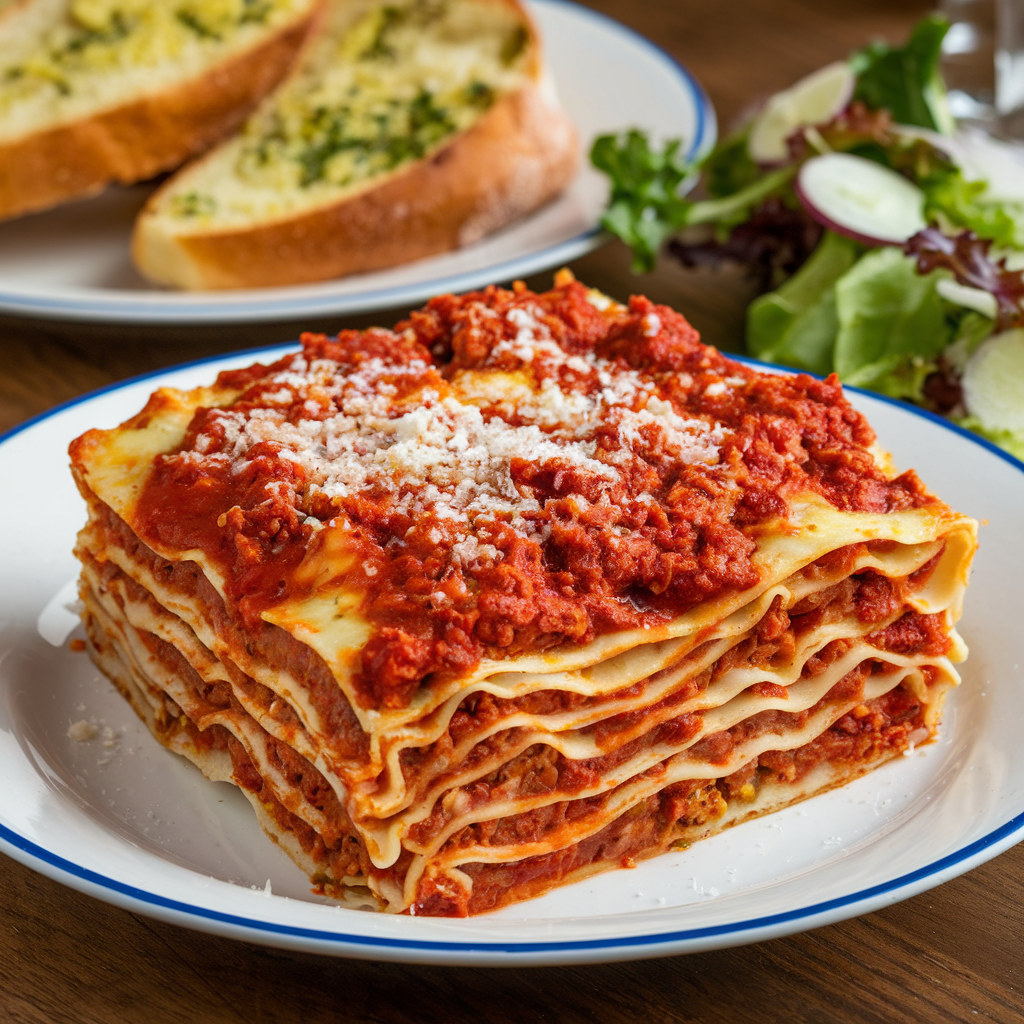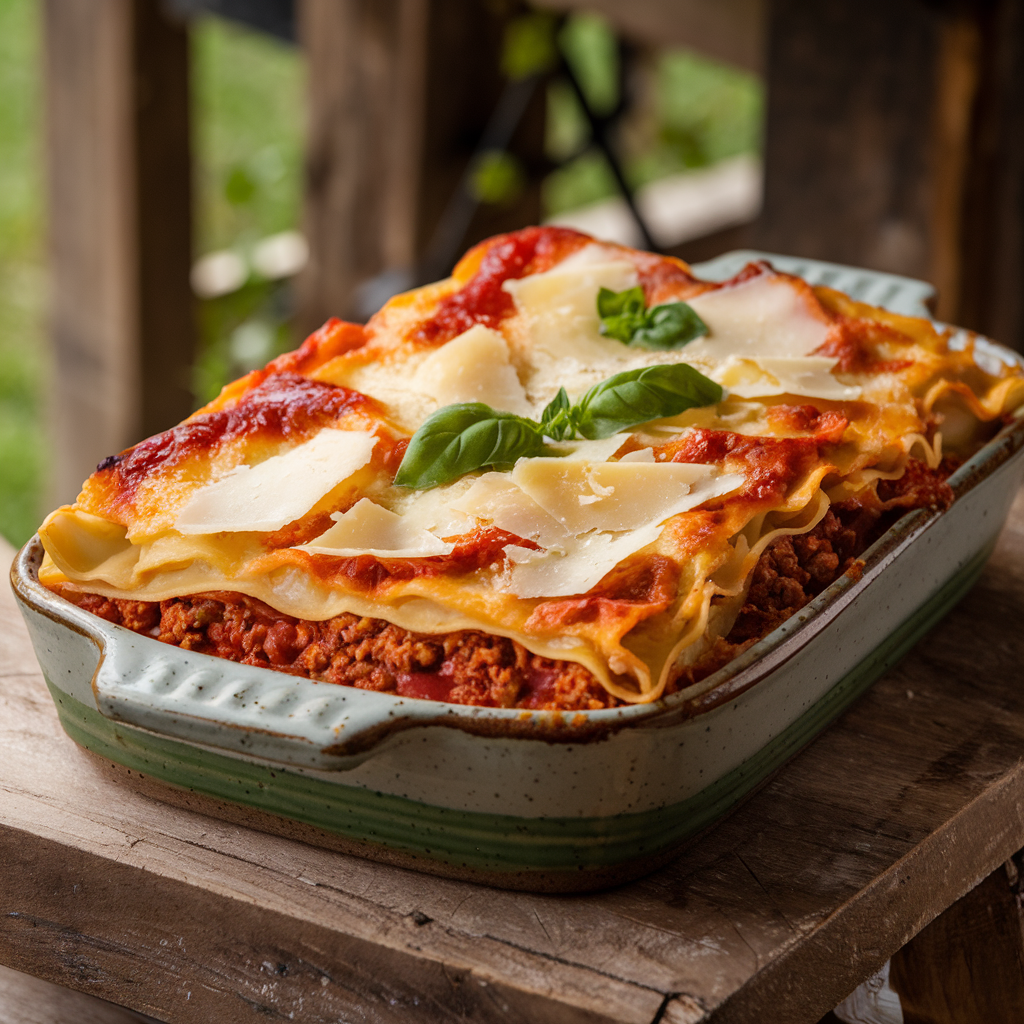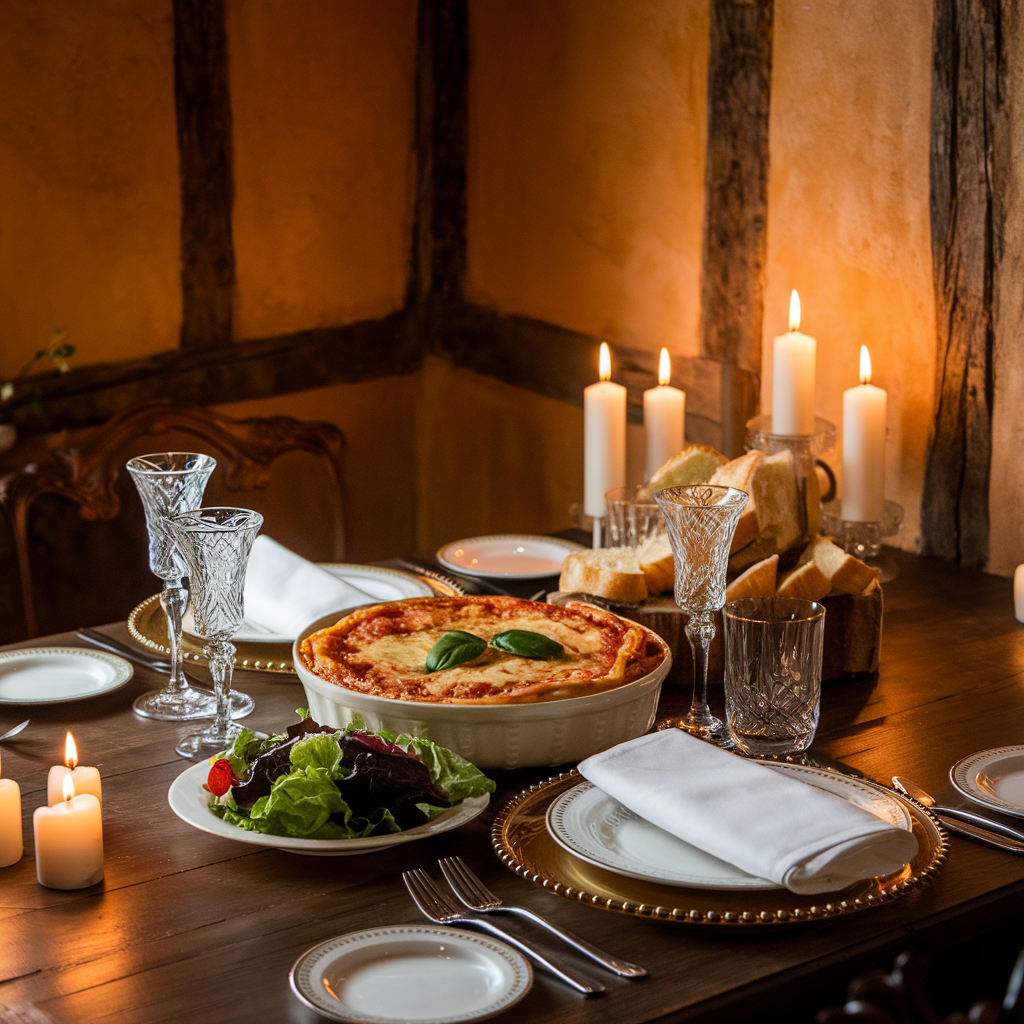Lasagna Bolognese is a beloved Italian dish made by layering pasta sheets, Bolognese sauce, béchamel, and cheese, resulting in a rich and satisfying casserole baked to golden perfection. It hails from the Emilia-Romagna region, epitomizing the heart of Italian comfort food.
The History and Origins of Lasagna Bolognese
The roots of lasagna trace back to ancient Rome, but the dish we know today evolved in Italy’s Emilia-Romagna region. “Lasagna” itself derives from the Greek word “lasanon,” meaning a cooking pot. The introduction of pasta and tomato-based sauces in later centuries shaped the modern version of lasagna. Specifically, the Bolognese variety gained popularity for its rich meat sauce, symbolizing the culinary excellence of Bologna.
Traditional vs. Modern Interpretations

Traditional Lasagna Bolognese adheres to time-honored methods: handmade pasta, slow-cooked Bolognese sauce, and a simple béchamel. Modern interpretations, however, experiment with shortcuts, alternative ingredients, and innovative flavors, such as using ricotta instead of béchamel or adding vegetables like spinach or zucchini. While both versions deliver delightful meals, purists argue that the traditional recipe offers an unmatched authenticity and flavor depth.
Key Ingredients for Authentic Lasagna Bolognese
Selecting the Best Pasta Sheets
Fresh, handmade pasta sheets are the hallmark of an authentic lasagna. Made from flour and eggs, they offer a tender texture that absorbs the sauces beautifully. If fresh pasta isn’t available, high-quality dried lasagna sheets can be used, ensuring they are pre-boiled if required.
Crafting the Perfect Bolognese Sauce
Bolognese sauce, the star of the dish, requires a slow-cooking process to develop its rich flavors. Ingredients include a mixture of ground beef and pork, carrots, celery, onion, tomato paste, and a splash of red or white wine. Milk is often added for a smoother texture. Allowing the sauce to simmer for hours is crucial for achieving the deep, robust flavor that defines this dish.
Choosing the Right Cheese Blend
A blend of cheeses enhances the dish’s creaminess and adds a golden crust. Parmigiano-Reggiano is the traditional choice for its nutty, umami flavor. Mozzarella can be added for meltiness, and a touch of pecorino provides a sharp finish. Balancing these cheeses ensures a delectable topping without overpowering the Recipe items .
Step-by-Step Recipe for Lasagna Bolognese
- Prepare the Bolognese Sauce:
- Sauté onions, carrots, and celery in olive oil.
- Add ground meat and brown thoroughly.
- Stir in tomato paste, wine, and milk. Simmer for 2–3 hours.
- Make the Béchamel Sauce:
- Melt butter in a saucepan and whisk in flour to create a roux.
- Gradually add milk, whisking constantly, until thickened.
- Season with salt, pepper, and a pinch of nutmeg.
- Assemble the Lasagna:
- Preheat the oven to 375°F (190°C).
- Spread a thin layer of Bolognese sauce in a baking dish.
- Layer pasta sheets, Bolognese, béchamel, and cheese. Repeat until all Recipe items are used, finishing with a generous cheese topping.
- Bake:
- Cover the dish with foil and bake for 25 minutes.
- Remove the foil and bake for an additional 15 minutes, or until the top is golden and bubbly.
- Serve:
- Allow the lasagna to rest for 10 minutes before slicing. Serve with a side salad or crusty bread for a complete meal.
Enjoy this quintessential Italian masterpiece, savoring the layers of flavor and tradition!
Variations of Lasagna Bolognese
Vegetarian and Vegan Alternatives
Replace the Bolognese sauce with a vegetable-based sauce made from lentils, mushrooms, or plant-based meat substitutes. Use dairy-free béchamel and cheese for a vegan option.
Gluten-Free and Keto-Friendly Options
Opt for gluten-free pasta sheets or thinly sliced zucchini or eggplant as a substitute. For keto-friendly lasagna, use low-carb vegetables instead of pasta and make a béchamel with almond flour.
Health and Nutrition in Lasagna Bolognese
Lasagna Bolognese can be adapted to suit dietary preferences and health goals. Use lean meats, whole-grain pasta, or low-fat cheese to reduce calories. Adding vegetables to the sauce or as layers can increase fiber and nutrient content. While indulgent, Recipe items choices can make this dish a balanced part of any diet.
Enjoy this culinary masterpiece, whether in its classic form or as a modern variation tailored to your preferences!

FAQs About Lasagna Bolognese
How Long Can Lasagna Bolognese Be Stored?
- Refrigerator: Store in an airtight container for up to 3–5 days.
- Freezer: Properly sealed, it can last up to 3 months. Defrost in the fridge overnight before reheating.
Can Lasagna Bolognese Be Made Ahead of Time?
Yes, you can assemble it up to 24 hours in advance. Cover tightly with foil and refrigerate until ready to bake.
What’s the Secret to a Rich Bolognese Sauce?
- Slow cooking for at least 2–3 hours allows flavors to deepen.
- Add a splash of wine and milk to enhance complexity and creaminess.
How Many Layers Should a Perfect Lasagna Have?
Typically, a lasagna has 3–5 layers. More layers create a luxurious feel, but too many can causeThe dish may fall apart. .
What’s the Best Way to Reheat Lasagna Bolognese?
Reheat individual portions in the microwave or an entire dish in the oven:
- Oven: Cover with foil and bake at 350°F (175°C) until heated through, about 20–30 minutes.
- Microwave: Heat individual servings on medium power to avoid drying out.
Can You Freeze Lasagna Bolognese?
Yes, it freezes well:
- Unbaked: Assemble the lasagna, wrap tightly, and freeze for up to 3 months.
- Baked: Cool completely before freezing. Reheat directly from frozen or thaw overnight.
What’s the difference between lasagna and lasagna Bolognese?
- Lasagna: Refers to a general baked pasta dish made by layering pasta sheets with various fillings, which can include meat, vegetables, cheese, and different types of sauces.
- Lasagna Bolognese: A specific type of lasagna that features Bolognese sauce (a rich meat sauce from Bologna, Italy) and béchamel sauce as key components. It’s a more traditional and regionally specific version of lasagna, known for its hearty and creamy layers.
What is Lasagna Bolognese made of?
Lasagna Bolognese is typically made with:
- Pasta Sheets: Fresh or dried lasagna noodles.
- Bolognese Sauce: A slow-cooked meat sauce made with ground beef and/or pork, vegetables, wine, tomato paste, and milk.
- Béchamel Sauce: A creamy white sauce made from butter, flour, and milk.
- Cheese: Parmigiano-Reggiano is traditional, often combined with stretchy cheese or pecorino for added flavor.
What is Bolognese sauce made of?
Bolognese sauce is a slow-cooked, rich meat sauce with a smooth texture. Ingredients typically include:
- Ground Meat: Traditionally a mix of beef and pork.
- Vegetables: Finely chopped onion, celery, and carrot (soffritto).
- Tomato Paste: For a mild tomato flavor, often less dominant than in a standard tomato sauce.
- Milk or Cream: To mellow the acidity of the tomatoes and add richness.
- Wine: Red or white wine for depth of flavor.
- Seasonings: Salt, pepper, and sometimes a hint of nutmeg.
What is the difference between meat sauce and Bolognese?
- Meat Sauce: A general term for any sauce that includes ground or chopped meat combined with a tomato base. It’s often quick to prepare and has a strong tomato-forward flavor.
- Bolognese: A specific type of meat sauce originating from Bologna, Italy. It’s characterized by:
- A higher meat-to-tomato ratio.
- The inclusion of milk or cream for a smoother texture.
- A slower cooking process (2–4 hours) for deep, complex flavors.
- A less acidic, less tomato-heavy profile compared to typical meat sauces.
Bolognese is more refined and traditional, while meat sauce is versatile and varies widely based on regional or personal preferences.
- Hosting the Perfect Lasagna Dinner: Explore tips for planning a memorable lasagna-themed dinner, with insights into complementary dishes and preparation strategies.
- What Is the Difference Between Italian Lasagna and American Lasagna?: Discover how regional differences shape the preparation and flavors of lasagna.
- How to Make Fresh Pasta: Learn the art of making homemade pasta, an essential skill for crafting authentic lasagna Bolognese.
For more tips, check out Hosting the Perfect Lasagna Dinner.
Variations and Adaptations
From gluten-free to vegetarian alternatives, Lasagna Bolognese can be tailored to suit various preferences. For example:
- Substitute vegetables for meat to make a vegetarian version.
- Use zucchini slices instead of pasta for a keto-friendly alternative.
Dive Deeper Into Italian Cuisine
Explore other iconic Italian dishes and culinary tips, such as:
- How to Make Fresh Pasta for your next lasagna.
- What Is the Difference Between Italian Lasagna and American Lasagna? for insights into regional distinctions.
Lasagna Bolognese is more than a meal—it’s a culinary art that brings people together. Whether you stick to tradition or try modern adaptations, it promises a satisfying experience every time.
Conclusion
Summarizing the Joy of Cooking Lasagna Bolognese
Cooking Lasagna Bolognese is more than just preparing a meal—it’s an opportunity to immerse yourself in the rich traditions of Italian cuisine. From the slow-cooked Bolognese sauce to the creamy béchamel and carefully layered pasta, every step is a celebration of flavor, texture, and culinary artistry.
This iconic dish embodies comfort and indulgence, making it perfect for family gatherings, special occasions, or even a quiet evening at home. Whether you choose to follow the traditional recipe or explore modern adaptations, the result is always a hearty, satisfying masterpiece that brings people together.
Lasagna Bolognese is more than just food—it’s a testament to the joy of cooking, where time, care, and passion transform simple Recipe itemsinto something extraordinary. Share it, savor it, and let it become a cherished part of your culinary journey.

